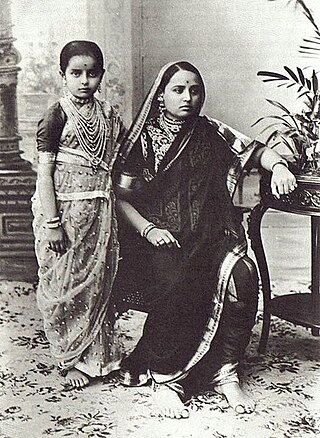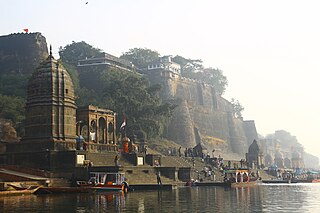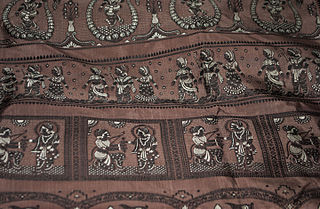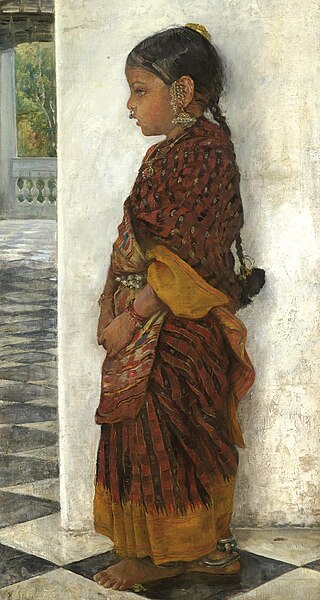
Rehwa Society is a not-for-profit foundation, working with weavers in Maheshwar, Madhya Pradesh. Established in 1978, by Richard and Sally Holkar as a weaver's society. It is known for its Maheshwar sarees, in silk and cotton.

Rehwa Society is a not-for-profit foundation, working with weavers in Maheshwar, Madhya Pradesh. Established in 1978, by Richard and Sally Holkar as a weaver's society. It is known for its Maheshwar sarees, in silk and cotton.

The weaving history at Maheshwar, dates back to Maharani Ahilyabai Holkar, the ruler of princely Indore State from 1765 to 1795. She brought in weavers from Surat in Gujarat and Mandu, Madhya Pradesh and established them at Maheshwar, to weave special nine-yard saris (Navvari saris) for the ladies of royal household, and turban fabric. [1] [2]

The tradition was revived, when the Rehwa Society was founded in 1978, by Richard Holkar of Holkar dynasty and his wife Sally Holkar. Using a grant from the Indian Central Welfare Board, they started with eight looms and eight women weavers from the local Meru community. It is situated within the Ahilya Fort at Maheshwar, on the banks of the Narmada River. Over the years the society has expanded to 250 weavers, most of them women and 110 looms. It is known for weaving Maheshwari sarees and fabric in cotton and silk. [1] [3]
Sally Holkar managed the society till 2003, when we established WomenWeave Charitable Trust, also based in Maheshwar. [4] Thereafter, Mira Sagar who has worked with Rehwa for 20 years, remained the director of Rehwa Society, before starting her own line in 2012. [5] [6] [7]
Today, Rehwa Society has retail outlets in cities like New Delhi and Mumbai, and in 2003 has a turnover of ₹1.5 crore (US$190,000). [2] Since the society is non-profit, the profits are used in employee welfare. A small colony of 45 houses has been built for the employees, which the weavers paid through their work. Besides a school till eighth standard and a creche has also been built. [5]

A sari is a women's garment from the Indian subcontinent, that consists of an un-stitched stretch of woven fabric arranged over the body as a robe, with one end attached to the waist, while the other end rests over one shoulder as a stole (shawl), sometimes baring a part of the midriff. It may vary from 4.1 to 8.2 metres in length, and 60 to 120 centimetres in breadth, and is form of ethnic wear in India, Sri Lanka, Nepal, Bangladesh and Pakistan. There are various names and styles of sari manufacture and draping, the most common being the Nivi style. The sari is worn with a fitted bodice also called a choli and a petticoat called ghagra, parkar, or ul-pavadai. It remains fashionable in the Indian subcontinent today.
Ikat is a dyeing technique from Indonesia used to pattern textiles that employs resist dyeing on the yarns prior to dyeing and weaving the fabric. The term is also used to refer to related and unrelated traditions in other cultures. In Southeast Asia, where it is the most widespread, ikat weaving traditions can be divided into two general clades. The first is found among Daic-speaking peoples. The second, larger group is found among the Austronesian peoples and spread via the Austronesian expansion. Similar dyeing and weaving techniques that developed independently are also present in other regions of the world, including India, Central Asia, Japan, Africa, and the Americas.

Maheshwar is a town, near Khargone city in Khargone district of Madhya Pradesh state, in central India. It is located on State Highway-38 ,13.5 km east of National Highway 3 and 91 km from Indore, the commercial capital of the state. The Town lies on the north bank of the Narmada River. It was the kingdom of Chaktavartin Samrat Sahastraarjun, Kartavirya Arjuna a Heheya king. Lately, after many years, it was the capital of the Malwa during the Maratha Holkar reign till 6 January 1818, when the capital was shifted to Indore by Malhar Rao Holkar III.

Paithani is a variety of sari, named after the Paithan town in Aurangabad district from state of Maharashtra in India where the sari was first made by hand. Present day Yeola town in Nashik, Maharashtra is the largest manufacturer of Paithani.

A Banarasi sari is a sari made in Varanasi, an ancient city which is also called Benares (Banaras). The saris are among the finest saris in India and are known for their gold and silver brocade or zari, fine silk and opulent embroidery. The saris are made of finely woven silk and are decorated with intricate designs, and, because of these engravings, are relatively heavy.

Silk In India, about 97% of the raw mulberry silk is produced in the Indian states of Karnataka, Andhra Pradesh, Tamil Nadu and West Bengal. Mysore and North Bangalore, the upcoming site of a US$20 million "Silk City", contribute to a majority of silk production. Another emerging silk producer is Tamil Nadu in the place in where mulberry cultivation is concentrated in Salem, Erode and Dharmapuri districts. Hyderabad, Andhra Pradesh and Gobichettipalayam, Tamil Nadu were the first locations to have automated silk reeling units.

Kota Doria or Kota Doriya is the name of a light woven fabric made of tiny woven squares (khat) which is still handwoven on traditional pit looms in Kaithoon near Kota in Rajasthan and in some of the surrounding villages. Kota Doriya Sarees are made of pure cotton and silk and have square like patterns known as khats on them. The chequered weave of a Kota sari is very popular for their lightweight and comfortable wear. They are very fine weaves and weigh very little.

Kerala sari (Set-sari) is a clothing of women in the Indian state of Kerala.

A Sambalpuri sari is a traditional handwoven bandha (ikat) sari wherein the warp and the weft are tie-dyed before weaving. It is produced in the Sambalpur, Balangir, Bargarh, Boudh and Sonepur districts of Odisha, India. The sari is a traditional female garment in the Indian subcontinent consisting of a strip of unstitched cloth ranging from four to nine meters in length that is draped over the body in various styles.

Baluchari Sari is a type of sari, a garment worn by women in Bangladesh and Indian states of West Bengal, Tripura and Assam. This particular type of sari originated in West Bengal and is known for depictions of mythological scenes on the anchal of the sari. It used to be produced in Murshidabad but presently Bishnupur and its surrounding areas of West Bengal are the only place where authentic Baluchari saris are produced. It takes approximately one week to produce one such sari. In 2011, the Baluchari Sari was granted the status of Geographical Indication for West Bengal in India.

The Chanderi sari is a traditional Koli sari made in Chanderi, Madhya Pradesh, India.
Uppada Jamdani Saree is a silk sari style woven in Uppada of East Godavari district in the Indian state of Andhra Pradesh. It was registered as one of the geographical indication from Andhra Pradesh by Geographical Indications of Goods Act, 1999. Uppada Jamdani saris are known for their light weight.

Pochampally sari or Pochampalli ikat is a saree made in Bhoodan Pochampally, Yadadri Bhuvanagiri district, Telangana State, India. They have traditional geometric patterns in "Paagadu Bandhu" (Ikat) style of dyeing. The intricate geometric designs find their way into sarees and dress materials. The Indian government's official airplane company, Air India, has its cabin crew wear specially designed Pochampally silk sarees.
Venkatagiri Sari is a sari style woven in Venkatagiri of Tirupati district in the Indian state of Andhra Pradesh. It was registered as one of the geographical indication from Andhra Pradesh by Geographical Indications of Goods Act, 1999. Venkatagiri saris are known for their fine weaving. These style of saris can also be found in the villages of Sengunthapuram, Variyankaval, Elaiyur, Kallathur, Andimadam and Marudhur villages.
Kovai Cora cotton or Kovai Kora cotton is a type of saree made in the Coimbatore region in Tamil Nadu, India. It has been recognized as a Geographical indication by the Government of India in 2014–15. The Devanga community are pioneers in weaving Kovai Kora cotton saris. 82 Weaver cooperative Societies in Coimbatore, Tiruppur and Erode are authorised to sell Kovai Kora cotton saris.

Handloom saris are a traditional textile art of Bangladesh and India. The production of handloom saris is important for economic development in rural India.
Mangalagiri Sarees and Fabrics are produced by performing handicraft weaving in Mangalagiri, a town in Guntur district of the Indian state of Andhra Pradesh. It was registered as one of the handicraft in the geographical indication from Andhra Pradesh by Geographical Indications of Goods Act, 1999.

Chendamangalam Saree is a traditional hand woven cotton sari from Chendamangalam, Ernakulam district of Kerala. This saree is part of the Chendamangalam Handloom tradition of Kerala.

Tangail saree is a traditional handwoven saree (Sari) of West Bengal. It is produced in Purba Bardhaman & Nadia districts of West Bengal. These handlooms are famous for the novelty of saree designs, hand-woven booties, use of natural fibers in the weave and saree fineness of the fabric. In 2024, Tangail Saree was recognized as a Registered Geographical Indication under the title Tangail Saree of Bengal and Banglar Tangail Saree in Bengali language.

Tangail saree is a traditional handwoven saree of Bangladesh. Its origin is Tangail district of the country. A different form of the saree is also popular in West Bengal, India and is a registered GI indication in the state.